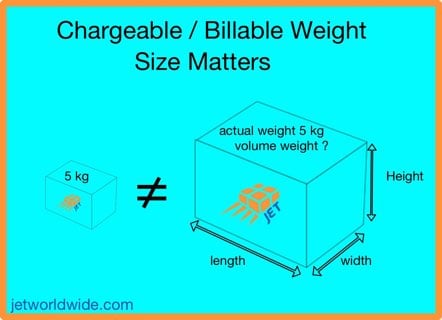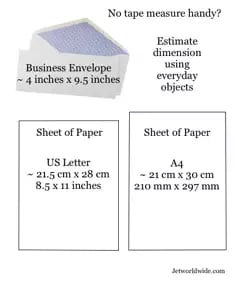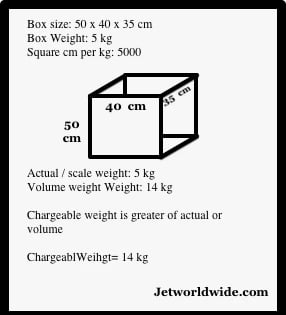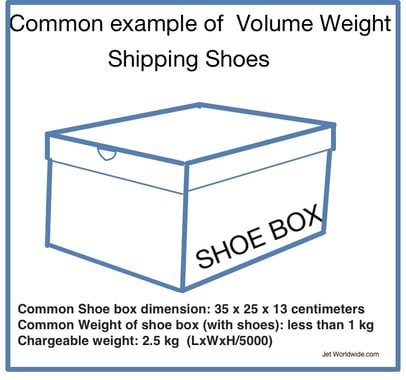
Chargeable Volume Weight explained
Chargeable weight: Actual Weight versus Volume Weight explained
Perhaps one of the biggest questions we get from new shippers concerns the calculation of volume weight. Volume weight, also known as dimensional weight, is a method used to calculate the weight of a package based on its size, rather than its actual weight. It is often used by carriers and logistics companies to determine the shipping cost for packages that are large or bulky, but relatively light in weight.
The chargeable weight of a shipment is the weight used to calculate the cost of shipping a package or freight. It is typically the greater of either the actual weight of the shipment or its volumetric weight, which is a calculation based on the dimensions of the package.
The volumetric weight is used to account for the amount of space a package takes up on a truck, boat or plane, rather than just its physical weight. The idea is that larger, lighter packages take up more space and therefore cost more to ship. The actual weight is universally expressed in kilograms or pounds. The formula used to equate size with weight varies according to the carrier and method of shipping.
 Expand your cross border transportation and logistics options. Grow your understanding of the how, why from a company providing logistics solutions for over 40 years! Strengthening your transportation team - even if you are a team of one!
Expand your cross border transportation and logistics options. Grow your understanding of the how, why from a company providing logistics solutions for over 40 years! Strengthening your transportation team - even if you are a team of one!
Gain from a discussion with our seasoned professionals. Contact our team for an initial consultation.
What is "volume weight"?
All delivery companies (including FedEx, UPS, USPS, Canada Post, Purolator) consider their cost based on the weight and size of an item. A large shipment that takes up a disproportionate amount of space can be just as costly to handle versus a smaller - yet heavier - item.

To calculate the volume weight of a package, the length, width, and height of the package are measured in centimeters, and the volume is calculated by multiplying these dimensions together. The resulting volume is then divided by a conversion factor to convert it to kilograms. The conversion factor varies depending on the carrier and the shipping destination, but it is typically around 5000 or 6000 cubic centimeters per kilogram.
For example, if a package has dimensions of 50 cm x 40 cm x 30 cm, the volume of the package would be 50 x 40 x 30 = 60,000 cubic centimeters. If the conversion factor is 5000 cubic centimeters per kilogram, the volume weight of the package would be 60,000/5000 = 12 kilograms.
In cases where the volume weight of a package is greater than its actual weight, the carrier will charge the higher amount as the shipping cost. This is because it is more expensive to transport large, bulky packages due to the extra space they occupy in the transportation vehicle.
Low Density Cargo is charged higher than the actual weight.
One of the best ways to explain volume pricing is when a "really big shipment does not weight much." In industry terms, this is described as Low Density Cargo: Low density cargo, is charged at “volume weight” rather than actual weight.

What is "chargeable or billable" weight?
Chargeable weight -or "billable weight" is the higher of actual or dimensional weight. Dimensional weight applies if the volume weight is greater than actual weight.
The formula used to calculate volume weight by many express carriers is:
Length x Width x Height (in cm)/ 5000 = dimensional weight in Kilograms
The actual formula to calculate the volume weight can vary by carrier and type of service. The volume weight of parcels sent via ground (versus air), for example, are often calculated via a different formula.
Check with your carrier to confirm their policy on volume weight and confirm how volume weight will be calculated for your shipment.
Download printable ruler on letter size sheet of paper

Download printable ruler on A4 sheet of paper
Common Chargeable Weight Formula
The volume weight varies by carrier and method of transport but a common calculation for volume weight is:
Length x width x height (in cm) / 5000
- The product of the dimension in centimeters 50 x 40 x 35 is 70000
- 70000 divided by 5000 = 14 kg volume/ dimensional weight
- Volume or dimensional weight of 14 kg is larger than actual weight of 5 kg
- Chargeable weight: 14 kg

The Importance of "Declared Weight" and Chargeable Weight
It is important to be careful when declaring weights on your shipment as carriers do not automatically credit shipments when a shipper declares a higher weight than actual. For example, if a shipper mistakenly writes 10 kg in instead of 1 kg, they will be charged for 10 kg. Carriers are reluctant to credit the difference (and often refuse!) as their policy on chargeable weight declared weight in their chargeable weight calculation.
The chargeable weight of many carriers is based on the higher of the following three factors:
- Actual Weight
- Volume or Dimensional Weight
- Declared Weight
For heavy freight shipments, the measurement used is "cubic Meters" or CBM.
Visit our related blog on volume weight and of calculating CBM
Package Measurements: Always round up - when calculating costs:
All carriers systematically scan and capture the weight and dimension of each package; rounding up to the nearest inch or centimeters.

It is important to note that carriers will not lower “over declared” dimensions. It is best to be accurate but not to over declare either the weight or dimension with the carrier.
There are several shipping options available for International shipping from and towards Canada
- Local Postal Service: Local parcel post options are generally the best option for individuals shipping small packages and personal items.
- Air Freight: This is the quickest with delivery usually in a couple days.
- Sea Freight: A cost-effective solution for large commercial orders. Sea freight is ideal for shipping larger container size shipments and non-perishable goods. Delivery time can take around 1-2 months.
- Express Courier: Integrated couriers such as DHL, UPS, or FedEx offer express and economy shipping options. Shipper can deal directly with these carriers or via one of their parters.
- Multi-modal: Combination of Air, Sea and road freight : This method is used for large cargo using a global freight forwarder.
- It is always recommended to consider the cost, the time and the nature of the cargo before selecting any option. And have a clear communication with the freight forwarder or logistics provider to ensure that the shipment arrives on time and meets all customs and import regulations.

Information and Rates Request Form
OTHER USEFUL SHIPPING INFORMATION TO VERIFY PRIOR TO SHIPPING
 Understanding Duty and How it is calculated
Understanding Duty and How it is calculated
 How to assign a value for international shipments
How to assign a value for international shipments
 Canada's Free Trade Agreements and duty free import
Canada's Free Trade Agreements and duty free import
Disclaimer: The information in all Jet Worldwide online content, including this post, is for general information only and is not intended to, constitute legal and/or tax advice.All liability with respect to actions taken or not taken based on the contents of this site are hereby expressly disclaimed. The content on this posting is provided “as is”; no representations are made that the content is error-free.
JetWorldwide.com/contact







